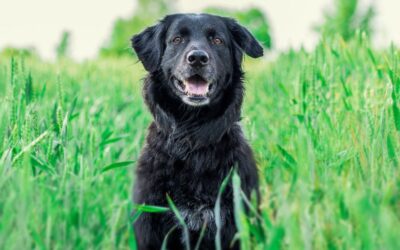Dogs bend their paws to distribute their weight and maintain balance while walking or running. Their flexible paw pads allow for better traction on various surfaces.
- Understanding The Anatomy Of A Dog's Paw
- The Mechanism Of Paw Bending In Dogs
- The Benefits Of Paw Bending For Dogs
- Factors Affecting Paw Bending In Dogs
- Common Paw Conditions That Affect Paw Bending
- Tips For Maintaining Healthy Paw Bending In Dogs
- Frequently Asked Questions Of Why Do Dogs Bend Their Paws
- Conclusion
Dogs and their adorable paws have always fascinated humans. These incredible creatures are capable of running, jumping, and navigating through different terrains effortlessly. One interesting aspect of their paw anatomy is the ability to bend their paws. This curious behavior serves a crucial purpose in their daily activities.
By bending their paws, dogs are able to distribute their weight evenly and maintain balance, ensuring stability while walking or running. Furthermore, their flexible paw pads provide them with enhanced traction, allowing them to navigate on different surfaces without slipping. We will explore the reasons why dogs bend their paws and shed light on the fascinating mechanisms at play. Let’s dive into the wonderful world of dog paws and uncover their secrets.
Understanding The Anatomy Of A Dog’s Paw
Understanding the anatomy of a dog’s paw is crucial if you want to comprehend why dogs bend their paws and how they are able to move and balance so effortlessly. A dog’s paw is a complex structure consisting of bones, joints, and tendons that work together seamlessly to provide the necessary support and flexibility for their daily activities. Let’s take a closer look at the structure of a dog’s paw and the role it plays in their movement and balance.
The Structure Of A Dog’s Paw: Bones, Joints, And Tendons
The bones in a dog’s paw are similar to those in a human hand but with a few key differences. A dog’s paw typically contains five main toes, each connected to small bones called phalanges. These phalanges are arranged in a pattern that allows for a wide range of motion, making the paw highly flexible and adaptable.
Connecting the phalanges are various joints, including the metacarpophalangeal joint, which corresponds to the knuckles in a human hand. These joints are supported by ligaments, which provide stability and prevent excessive movement.
The tendons in a dog’s paw play a crucial role in its functioning. Tendons are tough, fibrous tissues that connect muscles to bones, allowing for movement and transmitting forces. In the paw, tendons run along the back and bottom, providing support and facilitating the bending and stretching of the toes.
The Role Of The Paw In A Dog’s Movement And Balance
A dog’s paw is essential for their movement and balance, acting as a foundation that allows them to walk, run, jump, and perform other physical activities. The bones, joints, and tendons work together to provide stability, flexibility, and shock absorption.
When a dog walks, each paw hits the ground in a specific sequence, providing a steady rhythmic movement. This coordinated movement is achieved by the interaction between the joints and tendons, which allows the paw to adapt to different terrains and surfaces.
The paw also plays a vital role in a dog’s balance. The tendons and ligaments in the paw help distribute the dog’s weight evenly, ensuring stability even on uneven surfaces. The grip provided by the paw pads also helps improve traction, enhancing their ability to maintain balance and prevent slips or falls.
In conclusion, understanding the anatomy of a dog’s paw gives us insight into why dogs bend their paws and how they move and balance so effortlessly. The complex structure of bones, joints, and tendons allows for a wide range of motion, stability, and adaptation to different terrains. The paw is not only a functional part of a dog’s body but also an integral component that contributes to their overall agility and physical abilities.
The Mechanism Of Paw Bending In Dogs
Have you ever wondered why dogs bend their paws? It’s not just a random quirk but rather an essential function that helps them navigate their surroundings with ease. The flexibility of a dog’s paw and the role of their paw pads in shock absorption and traction play a significant role in this mechanism. Let’s dive deeper and understand how this bending mechanism works.
The Flexibility Of A Dog’s Paw: How It Allows Bending
A dog’s paw is not just a rigid structure; it is designed to be highly flexible to support their active lifestyle. The paw consists of several bones and joints that work together to provide a wide range of motion. The padding on the underside of the paw adds to its flexibility, allowing it to bend and adapt to different surfaces.
Dogs can bend their paws through the joint areas known as metacarpophalangeal joints, which are equivalent to the knuckles in humans. These joints act as hinges, enabling the paw to flex and extend during movement. The ligaments and tendons surrounding these joints provide stability while allowing the necessary flexibility.
Additionally, the paw pads that line the surface of the paw also play a crucial role in allowing bending. These thick and cushioned pads act as shock absorbers, protecting the bones and joints from excessive impact. The flexibility of the pads allows them to compress and expand, lessening the stress on the paw during vigorous activities like running or jumping.
The Function Of The Paw Pads In Absorbing Shock And Providing Traction
Paw pads aren’t just there for protection; they serve a vital function in a dog’s daily activities. The thick and durable nature of the pads helps absorb shock when the paw makes contact with the ground. This shock absorption prevents excessive stress on the bones and joints, reducing the risk of injuries or discomfort.
Another crucial role of the paw pads is to provide traction. The textured surface of these pads acts like a natural grip, helping dogs maintain their footing on various surfaces such as hardwood floors, grassy fields, or even slippery tiles. This traction is essential for dogs to have stability and control of their movement, especially during fast-paced or agile activities.
In conclusion, the mechanism of paw bending in dogs relies on the flexibility of their paws and the function of their paw pads. The flexible joints and padding allow dogs to adapt to different surfaces, while the paw pads absorb shock and provide traction. Understanding this mechanism helps us appreciate the incredible engineering behind our furry friends’ paws and their ability to maneuver effortlessly.
The Benefits Of Paw Bending For Dogs
The Benefits of Paw Bending for Dogs
Dogs are known for their incredible agility and maneuverability, and one of the reasons behind their impressive movement is their ability to bend their paws. Paw bending offers several benefits that contribute to a dog’s overall physical prowess and stability. In this article, we will explore these benefits in more detail.
Improved Agility And Maneuverability
Bending their paws allows dogs to have a greater range of motion, resulting in improved agility and maneuverability. When dogs bend their paws, they can easily navigate various terrains and obstacles with precision and ease. Whether it’s climbing over obstacles, jumping, or changing directions quickly, the flexibility in their paw joints gives them the advantage to move swiftly and effortlessly.
Enhanced Grip And Stability While Walking And Running
A crucial benefit of paw bending is the enhanced grip and stability it provides while dogs are walking or running. The joints in their paws enable them to adjust their paw pad angle, creating more traction with the ground. This improved grip ensures that their paws stay firmly planted, reducing the risk of slipping or losing balance, especially on slippery surfaces or uneven terrain.
Furthermore, the ability to bend their paws allows dogs to distribute their weight evenly, improving their overall stability. This evenly distributed weight distribution helps prevent injuries and maintains proper posture, allowing dogs to maintain their endurance and stay active for longer periods.
Bendable paws not only benefit dogs in their everyday activities but also play a vital role in specialized tasks such as agility training or working as service or rescue dogs. With the ability to bend their paws, these dogs can perform intricate movements and maneuvers with ease, excelling in their respective roles.
To conclude, the benefits of paw bending for dogs are vast. Improved agility and maneuverability, as well as enhanced grip and stability, greatly contribute to a dog’s overall physical capabilities and performance. Understanding the importance of this unique ability can help us appreciate the remarkable athleticism and agility of our furry friends.
Factors Affecting Paw Bending In Dogs
Breed-specific Characteristics: Differences In Paw Structure
Dogs come in a wide variety of breeds, each with their own unique characteristics, including variations in paw structure. Different breeds have been bred for various purposes, such as hunting, herding, or companionship, and these purposes have influenced the way their paws are shaped and function.
For example, breeds that were originally developed for speed and agility, like Greyhounds and Salukis, often have long, slender paws. These elongated paws allow them to cover more ground with each stride, providing better traction and reducing strain on their joints. On the other hand, breeds that were bred for digging and burrowing, like Dachshunds and Terriers, have shorter and more compact paws that enable them to easily maneuver underground.
The shape and size of a dog’s paws can also have an impact on their ability to navigate different terrains. Breeds that are adapted for rugged and mountainous terrains, such as St. Bernards and Tibetan Mastiffs, often have larger and wider paws. This provides them with enhanced stability and grip, allowing them to traverse uneven surfaces with ease. In contrast, breeds that were developed for water activities, such as Retrievers and Newfoundlands, may have webbed paws that aid in swimming.
Developmental Factors: How Puppies’ Paws Evolve Over Time
Just like humans, puppies’ bodies undergo significant changes as they grow and develop. This includes their paws, which evolve over time to support their increasing size and weight. Understanding the developmental factors that influence paw bending in puppies is essential for ensuring their overall health and well-being.
During the early stages of development, puppies’ paws consist mainly of soft cartilage. As they continue to grow, this cartilage gradually ossifies and hardens into bones. This process typically occurs between the ages of four to six weeks but can vary depending on the breed and individual puppy. It is crucial to provide puppies with appropriate nutrition during this period to support healthy bone development.
It is also important to note that puppies’ paws may appear larger in proportion to their bodies during the growing phase. This is because their bones and other tissues are still developing and need to catch up with their rapidly growing bodies. As puppies transition into adulthood, their paws will typically reach their final size and shape, although some minor changes may still occur.
Proper exercise during the developmental stage is vital for puppies’ paw health. Engaging in age-appropriate activities and avoiding excessive strain or high-impact exercises can help promote healthy muscle and joint development. Regular walks on different surfaces and gradual introduction to various terrains can also contribute to stronger and more resilient paws.
The factors affecting paw bending in dogs are multi-faceted, influenced by breed-specific characteristics and the developmental changes that occur during the growth stage. Understanding these factors allows us to provide the best possible care for our furry companions and ensure their paws remain strong and healthy throughout their lives.
Common Paw Conditions That Affect Paw Bending
Arthritis And Joint Issues In Dogs’ Paws
Dogs, just like humans, can experience arthritis and joint problems that can lead to the bending of their paws. Arthritis is a common condition that affects the joints and causes inflammation, pain, and stiffness. When arthritis affects the paws, it can make it difficult for dogs to move their paws properly, resulting in bending or abnormal posture.
There are several factors that can contribute to the development of arthritis in a dog’s paws. These include age, breed, genetics, obesity, and injury. As dogs age, the wear and tear on their joints increase, making them more prone to arthritis. Certain dog breeds, such as German Shepherds and Labrador Retrievers, are also more predisposed to developing joint problems.
Common symptoms of arthritis and joint issues in dogs’ paws include:
- Limping or reluctance to walk
- Swollen or tender paws
- Stiffness and difficulty in bending their paws
- Visible changes in paw posture
- Decreased activity levels
If you notice any of these symptoms in your dog, it’s important to consult with your veterinarian for a proper diagnosis and treatment plan. Treatment for arthritis in dogs’ paws may include medications, physical therapy, weight management, and joint supplements.
Paw Pad Injuries And Infections
Paw pad injuries and infections are another common cause of paw bending in dogs. The paw pads, which provide cushioning and protection, can be susceptible to injuries and infections due to their direct contact with the ground.
Common causes of paw pad injuries and infections include:
- Cuts or lacerations from sharp objects
- Burns from hot surfaces or chemicals
- Abrasions from rough terrains
- Frostbite from extreme cold
- Insect bites or stings
If a dog’s paw pad is injured or infected, they may experience pain, swelling, and difficulty in bearing weight on the affected paw. This can result in bending of the paw as the dog tries to alleviate the discomfort. It’s important to regularly inspect your dog’s paws for any signs of injuries or infections and seek veterinary care if needed.
Preventing paw pad injuries and infections involves taking proactive measures, such as keeping your dog’s nails trimmed, protecting their paws with booties or paw wax in extreme weather conditions, and avoiding sharp or hazardous surfaces during walks.
Tips For Maintaining Healthy Paw Bending In Dogs
As pet owners, it is our responsibility to ensure that our furry friends lead happy and healthy lives. One essential aspect of their well-being is maintaining the health of their paws. Dogs naturally bend their paws to provide traction, balance, and absorb shock while walking or running. However, improper paw bending can lead to discomfort and even serious injury. In this section, we will explore how you can maintain healthy paw bending in dogs, ensuring their overall well-being.
Regular Paw Inspections And Grooming
To maintain your dog’s paw health, it is crucial to inspect and groom their paws regularly. Regular paw inspections help you identify any cuts, scrapes, or foreign objects that may be causing discomfort. Here are some tips to follow:
- Inspect for debris: Regularly check your dog’s paws for any debris, such as dirt, stones, or twigs, that may have become lodged between their paw pads. Use a gentle touch to remove any foreign objects, ensuring you do not cause any harm.
- Trim nails: Keep your dog’s nails trimmed to prevent them from becoming overgrown and causing issues with paw bending. Use a proper dog nail trimmer and ensure you do not trim too much, as cutting into the quick can cause bleeding and pain.
- Moisturize paw pads: Dry or cracked paw pads can be uncomfortable for your dog. Apply a dog-friendly moisturizer to keep the paw pads soft and supple. This will promote proper bending while offering protection from harsh surfaces.
Providing Proper Nutrition And Exercise For Paw Health
Maintaining a balanced diet and regular exercise routine is essential for your dog’s overall health, including the health of their paws. Here are some important considerations:
- Choose quality nutrition: Feed your dog a high-quality diet that provides the necessary nutrients for healthy paw growth and strength. Consult with your veterinarian to determine the best diet plan for your dog’s specific needs.
- Encourage exercise: Regular exercise helps keep your dog’s joints and muscles strong, which directly impacts the health of their paws. Engage in activities that involve proper bending, such as walking, running, or playing fetch. This encourages natural paw movement and helps maintain flexibility.
- Be cautious of rough terrains: While exercise is important, be mindful of the surfaces your dog walks or runs on. Excessive strain on hard or rough terrains can lead to paw issues. Opt for softer terrains like grass or exercise on padded surfaces to reduce the impact on their paws.
By regularly inspecting and grooming your dog’s paws and providing them with proper nutrition and exercise, you can help maintain healthy paw bending. Remember, a little preventative care goes a long way in ensuring the well-being and happiness of your furry companion.
Frequently Asked Questions Of Why Do Dogs Bend Their Paws
Why Do Dogs Bend Their Paws While Walking?
Dogs bend their paws while walking to provide better shock absorption and stability. This allows them to navigate various terrains more effectively, reducing the risk of injuries. The bending of their paws also helps distribute their weight evenly, promoting a balanced gait.
What Is The Purpose Of Dogs Curling Their Paws While Resting?
Curling their paws while resting helps dogs conserve body heat. By tucking their paws under their bodies, they minimize the amount of exposed skin, reducing heat loss through their extremities. The curled position also provides them with a sense of comfort, security, and relaxation.
Do Dogs Bend Their Paws For Communication Purposes?
Yes, dogs may bend their paws as a form of communication. For example, a dog may raise a bent paw to signal submission or appeasement to another dog or human. It can also be a way for dogs to grab attention or solicit play from their owners.
Paying attention to your dog’s body language alongside paw positioning can give you valuable insights into their emotions and intentions.
Conclusion
Dogs bend their paws for several reasons. It is a natural instinct for them to help with traction and stability while running or playing. Additionally, bending their paws allows them to navigate uneven terrain more effectively. Understanding why dogs bend their paws is not only fascinating but also helps us appreciate their incredible adaptability and agility.
This knowledge can also provide valuable insights into dog behavior and enhance our bond with our furry companions.




